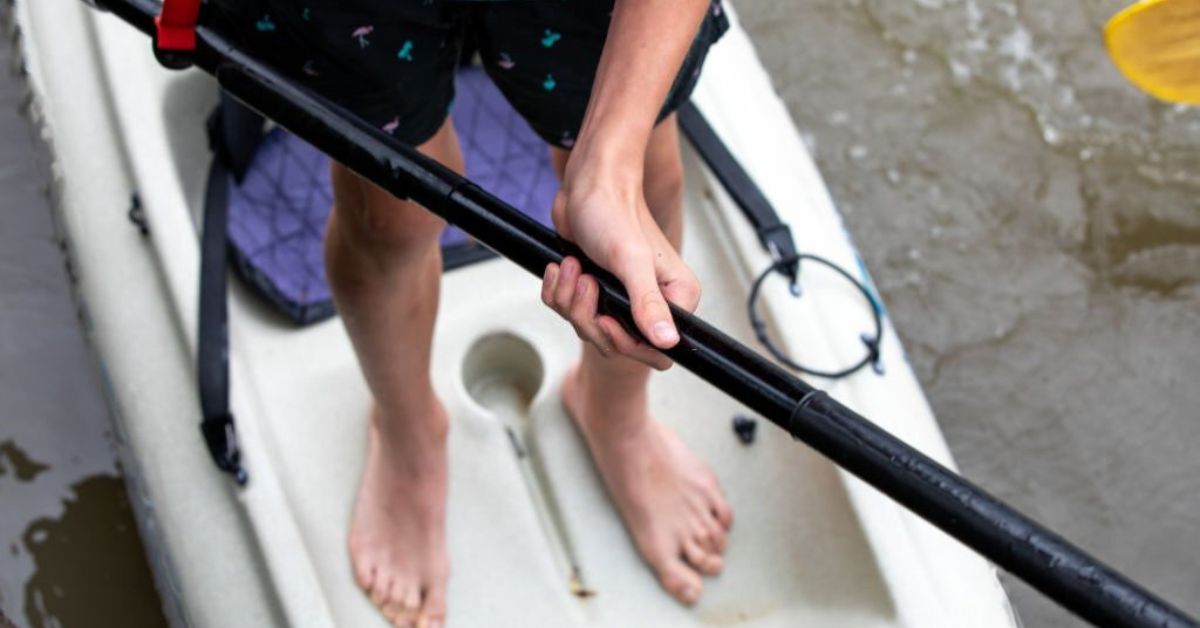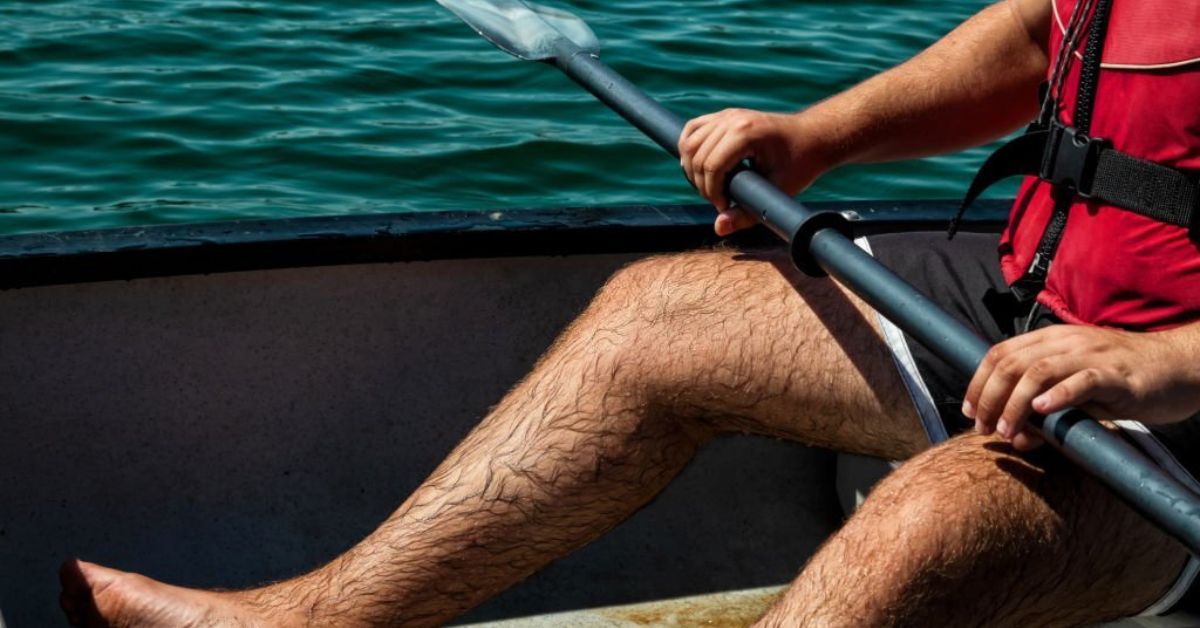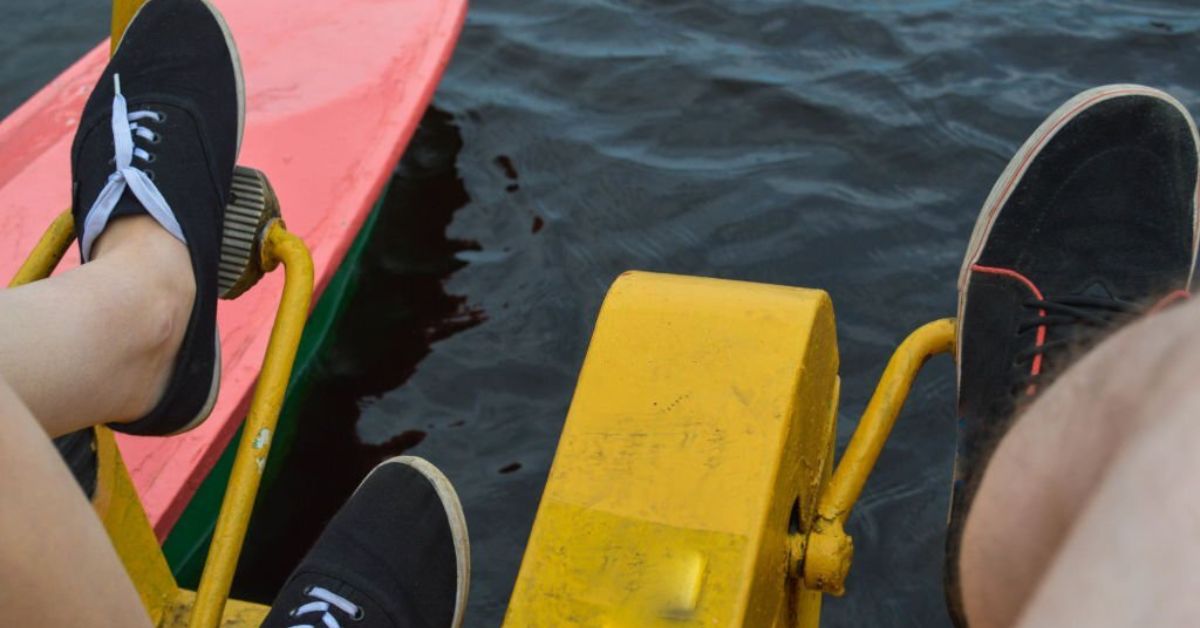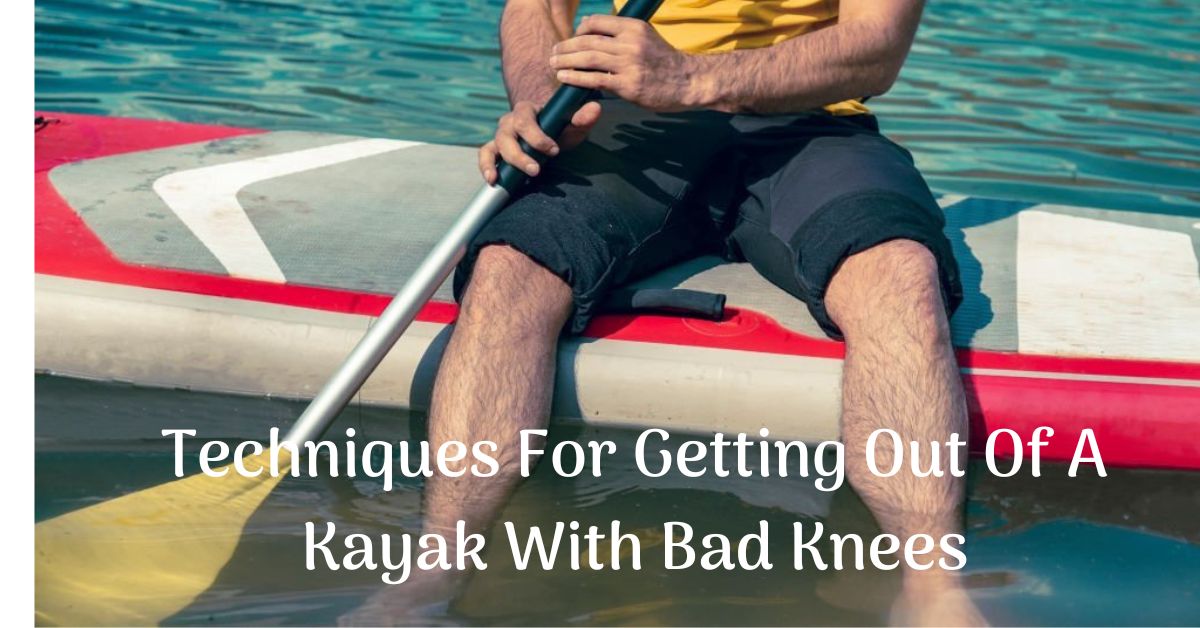Kayaking is a popular and fun activity that can be enjoyed by people of all ages and abilities. However, getting in and out of a kayak can be challenging, especially for those with bad knees.
In this post, we’ll share techniques and tips to make Getting Out of a Kayak with Bad Knees easier and more comfortable. These techniques have been tested and shown to work well for individuals with knee problems or difficulty moving.
Table of Contents
1. Introduction: The challenges of getting out of a kayak with bad knees
Kayaking is a fun and exciting activity. It lets us explore nature’s beauty and get a good workout. Getting out of a kayak can be difficult and uncomfortable for people with bad knees. If you have arthritis, previous knee injuries, or chronic knee pain, it’s important to find ways to make getting out of a kayak easier and less painful.
One of the primary difficulties lies in the confined space of a kayak cockpit. Exiting a kayak gracefully can be challenging if you have bad knees.
Limited legroom and the need to maintain balance while maneuvering make it difficult. Moreover, your knees can feel strained when you twist or bend to get out of the kayak. This can worsen pre-existing knee issues or potentially result in new injuries.
There are ways to help people with knee problems enjoy kayaking without pain and discomfort. In this article, we will talk about various ways to make getting out of a kayak easier and more knee-friendly.
If you have knee problems and still want to enjoy kayaking, these techniques can help. They reduce the strain on your knees. Let’s learn how to paddle and safely get out of a kayak for a comfortable and pain-free experience.
2. Understanding your limitations: Assessing your knee condition
If you have bad knees, it’s important to know and evaluate your knee condition before trying to get out of a kayak. Everyone’s knee limitations can vary. It’s important to be aware of movements or positions that may cause discomfort or pain.
Start by talking to a healthcare professional or physical therapist. They can give you advice about your knee condition. They can help you understand the limits of your knees. They can also suggest exercises or changes to keep your knees safe while kayaking.
Additionally, take the time to listen to your body and understand its signals. Be aware of any pain or discomfort while doing your usual activities or exercising. Being aware of your body will help you avoid putting strain on your knees when exiting a kayak.
It is also essential to be mindful of your physical strength and fitness level. Weak muscles around the knee joint can increase the risk of injury or exacerbate knee pain. Doing exercises that focus on the muscles that support your knees, like the quadriceps and hamstrings, can make your kayaking activities more stable and supported.
By knowing your limits and taking necessary precautions, you can have a safe and fun time kayaking, even if you have knee issues. Make sure to prioritize your health and well-being when doing physical activities. It’s a good idea to talk to a healthcare professional for personalized advice.
3. Choosing the right kayak: Factors to consider for better accessibility
Choosing the right kayak is important for people with bad knees to have easier access. Several things can affect how comfortable and easy it is for you to get in and out of a kayak.
Firstly, opt for a kayak with a wider cockpit. A wider cockpit gives you more space and makes it easier to move your legs, reducing strain on your knees. If you need an accessible kayak, look for models designed for people with specific needs. These kayaks have wider cockpits and additional features for greater comfort.

Secondly, consider the seating options. Look for kayaks that offer adjustable seats with ample padding and back support.
This will help reduce knee pressure and give your body better support overall. Sit-on-top kayaks can be a better choice for high school students. They offer more room for your legs and make getting in and out easier than sit-inside kayaks.
Additionally, pay attention to the kayak’s stability. Opt for kayaks with a wider and more stable hull design. This will make it safer and easier for people with knee problems to get in and out of the kayak.
Lastly, consider the weight of the kayak. Choose a lightweight kayak that you can easily handle and transport. To make it easier on your knees while loading and unloading, follow this advice.
Consider these factors when choosing a kayak. It will make it easier to access and ensure a more enjoyable paddling experience, even if you have bad knees. Investing in the right kayak can greatly enhance your comfort and make it easier to get in and out of the kayak.
4. Using proper technique: Step-by-step guide on getting out of a kayak with bad knees
If you have bad knees, getting out of a kayak can be a challenging task. With the correct technique, you can make the process easier and more comfortable. Here is a step-by-step guide to help you get out of a kayak with bad knees:
1. Prepare yourself: Before attempting to get out of the kayak, make sure you are in a stable position. Align your body with the side of the kayak and place your feet flat on the floor of the kayak.
2. Position your paddle: Hold onto your paddle with both hands and position it across the cockpit. This will provide you with additional stability as you prepare to exit the kayak.
3. Move to the edge: Slowly shift your weight towards the side of the kayak that you want to exit from. This will help to create a stable base and allow you to maintain balance throughout the process.
4. Lift your leg: Lift your leg that is on the side you want to exit from and place it outside of the kayak. Use your hands to support yourself as you lift your leg, ensuring that you do not put too much pressure on your knees.
5. Push yourself out: Using your hands and the paddle for support, push yourself out of the kayak and onto the ground. Take your time and go at your own pace to avoid any unnecessary strain on your knees.
6. Stand up slowly: Once you are out of the kayak, gradually stand up while keeping your weight evenly distributed. Avoid putting too much pressure on your knees by using your arms and hands for support.
Remember, it is important to listen to your body and take breaks if needed. If you experience any discomfort or pain while getting out of the kayak, consult with a medical professional before continuing with any physical activity.
5. Modifications and equipment: Helpful tools and accessories for easier exits
If you have bad knees, there are ways to make getting out of a kayak easier and more comfortable. You can use modifications and equipment options that are available. These tools and accessories can help support your knees, reduce pressure, and make it easier to get up and move.
Adding a kayak outrigger or stabilizer is a common modification. These devices can be attached to the kayak to add stability. This makes it easier to balance when getting in and out. Knee issues? These can be helpful. They lower the risk of tipping when you get out.
Another helpful accessory is a kayak seat cushion or pad. These cushions give extra padding and support to your knees.
They reduce discomfort and make it easier for you to get out more comfortably. When searching for kayak cushions, look for ones specifically designed for kayaking. These cushions are often made with materials that can resist water and dry quickly.

Additionally, consider using a kayak paddle with a wider blade or ergonomic grip. Using paddles can reduce strain on your wrists and elbows.
This can have an indirect impact on your knees when you finish. Choosing the right paddle is important for minimizing joint stress and making it easier to get out of the kayak. It should suit your body mechanics and have a natural grip.
If you have trouble moving around, it might help to get a kayak with a bigger opening or one where you sit on top. These styles provide extra space and flexibility.
They make it easier to move your legs and get out of the kayak without putting too much strain on your knees. Sit-on-top kayaks have an open design that makes it easy to get in and out of them. This is why they are a popular choice for people with mobility limitations.
By making these changes and using different gear while kayaking, you can have more fun and feel more comfortable.
This is especially important if you have problems with your knees. Make sure to talk to a doctor or physical therapist before deciding what’s best for you. They can help you figure out the right approach based on your needs and limits.
6. Stretching and exercises: Strengthening exercises and stretches to improve knee mobility
When it comes to getting out of a kayak with bad knees, it’s important to prioritize knee mobility and strength. Incorporating stretching exercises into your routine can greatly improve your flexibility and make the process of getting out of a kayak easier and less painful.
Before you begin any exercises, it’s essential to warm up your muscles. Start with gentle movements such as ankle rotations and leg swings to get the blood flowing to your knees. This will help prevent injury and prepare your joints for the exercises ahead.
Strengthening Exercises
One effective stretching exercise for improving knee mobility is the seated knee extension stretch. Sit on the edge of a chair with your back straight and your feet flat on the floor.
Slowly extend one leg out in front of you, keeping your heel on the ground and your toes pointing up. Hold the stretch for 15-30 seconds and then switch to the other leg. Repeat this stretch several times on each leg to gradually increase your range of motion.
Another helpful exercise for strengthening the muscles around your knees is the leg press. This exercise can be done using a resistance band or a leg press machine at the gym.
Sit on a chair or lie down on your back with your legs extended. Place the resistance band around your feet and push your legs forward, straightening your knees against the resistance. Repeat this motion for 10-15 reps to build strength in your knees.
Additionally, incorporating exercises that target the quadriceps and hamstrings can provide stability and support for your knees. Squats, lunges, and leg curls are all great options for strengthening these muscle groups.
Remember to start slowly and listen to your body. If you experience any pain or discomfort during these exercises, it’s important to stop and consult with a healthcare professional. They can provide personalized guidance and recommendations based on your specific needs.
By consistently incorporating stretching and strengthening exercises into your routine, you can improve knee mobility, reduce discomfort, and paddle with ease, even with bad knees.
7. Safety precautions: Tips to prevent injuries during the process
Preparation is key when kayaking, no matter what the destination. Whether you’re paddling for fun or fitness, following these safety guidelines will help to ensure a smooth and enjoyable experience.
1. Always wear a life jacket.
This may seem like a given, but many kayakers forget to put on a life jacket and end up getting into trouble. Kayaking is a great way to get some exercise, but it’s also a dangerous activity. If you’re not wearing a life jacket, you’ll likely end up getting into trouble and losing your balance.
2. Know your kayaking skills.
If you’re a beginner, it’s important to start with easy rivers or lakes. As you become more experienced, you can venture out to more challenging waters.
However, before you go out on your first expedition, it’s important to check with your local kayaking association to make sure the river or lake you plan to kayak is safe.
3. Respect the environment.
Always take care when you’re kayaking. Don’t litter, don’t disturb wildlife, and don’t run your boat into rocks. Not only will you be damaging the environment, you’ll also be risking your own safety.
4. Use common sense.
When kayaking, always use common sense. Don’t drive your boat into a river or lake if you can’t see the bottom. Don’t paddle into dangerous areas. And don’t attempt to do anything that you’re not sure you can do.
5. Follow the rules of the river or lake.
Many rivers and lakes have kayaking regulations in place. Make sure you know what they are and follow them. For example, many rivers have a maximum speed limit, and there may be restrictions on where you can and cannot kayak.
6. Respect the environment.
Always take care when you’re kayaking. Don’t litter, don’t disturb wildlife, and don’t run your boat into rocks. Not only will you be damaging the environment, you’ll also be risking your own safety.
7. Use common sense.
When kayaking, always use common sense. Don’t drive your boat into a river or lake if you can’t see the bottom. Don’t paddle into dangerous areas. And don’t attempt to do anything that you’re not sure you can do.
8. Alternative options: Exploring alternative watercraft for those with severe knee issues
If you struggle to exit a kayak due to severe knee problems, there’s no need to worry! There are other watercraft choices available that can offer you the pleasure of being on the water while being more knee-friendly.

One option to consider is a stand-up paddleboard (SUP). SUPs provide a stable platform that allows you to stand and paddle, eliminating the need to sit in a kayak. With a SUP, you can enjoy the freedom of movement and the ability to stretch your legs without the stress on your knees that comes with sitting for extended periods.
Another alternative is a canoe. Canoes offer a different paddling experience compared to kayaks but can be a great option for those with knee issues.
Canoes have an open design that allows you to sit comfortably with your legs stretched out or even kneel if that is more comfortable for you. This flexibility in seating positions can help alleviate the strain on your knees when entering or exiting the watercraft.
Additionally, consider inflatable kayaks. Inflatable kayaks are lightweight and easy to maneuver, making them a suitable option for individuals with knee issues.
They often have more spacious seating areas and lower sides, allowing for easier entry and exit. These kayaks can be deflated and stored compactly, making them convenient for transportation and storage.
Ultimately, the key is to find a watercraft that suits your specific needs and provides the necessary support for your knees. Don’t let knee issues discourage you from enjoying the water. Explore these alternative options and discover new ways to paddle with ease and comfort.
9. Expert advice: Insights and recommendations from experienced paddlers and healthcare professionals
If you have bad knees and want to go kayaking, make sure you ask experienced kayakers and healthcare professionals for advice. These people have useful ideas and advice that can greatly enhance your kayaking. They can also help you with the difficulties caused by knee problems.
Experienced paddlers who have had knee issues can give helpful advice and techniques that worked for them. Experienced guides know the ins and outs of paddling.
They can help you adjust your technique to protect your knees. They might recommend changes to how you swim. For example, they might suggest using shorter strokes or focusing on rotating your torso instead of relying only on your arms and legs.
Healthcare professionals, like orthopedic doctors or physical therapists, can give helpful advice for your specific knee problem.
They can evaluate your specific situation and recommend exercises or stretches to strengthen the muscles around your knees, increase flexibility, and alleviate pain and inflammation. They may suggest using knee braces or supportive gear to help stabilize while paddling.
Experts’ advice can greatly improve your kayaking experience. Their advice can help you find problems in how you paddle or give tips to avoid pain and injuries. Incorporate their suggestions to improve your kayaking. This will help you paddle with more ease and confidence, especially if you have bad knees.
Remember, the advice from experienced paddlers and healthcare professionals is helpful, but always consult with your own healthcare provider. Before trying any new exercises or techniques, make sure to talk to a doctor.
This is especially important if you have a knee problem or are healing from an injury. Their expertise will help you stay safe while enjoying kayaking. They will ensure you make informed decisions that prioritize your health.
10. Wrapping Up
Kayaking is an exciting and energizing activity. It lets us connect with nature and explore calm waterways.
However, for those with bad knees, the thought of getting in and out of a kayak can be daunting. Good news! You can still enjoy kayaking even if you have knee concerns. Just use the right techniques and strategies.
In this article, we’ve shared tips to help high school students with bad knees safely get out of a kayak. By using proper body mechanics and assistive devices like grab bars or kayak docks, you can reduce stress on your knees.
We also learned about the importance of flexibility exercises and stretching routines. These can help improve joints and reduce discomfort. To make your knees stronger while kayaking, do specific exercises regularly. These exercises will help build the muscles around your knees and provide them with extra support.
Investing in a kayak that is easier to use can make your kayaking experience better. You can look for features like a wider cockpit or adjustable footrests. These changes make the kayak more stable and comfortable. You can enjoy paddling without worrying about hurting your knees.
Ultimately, it is crucial to listen to your body and take breaks when needed. Overworking can strain your knees. It’s important to pace yourself and slowly increase your endurance for kayaking. Remember, kayaking is not about racing. It’s a chance to connect with nature and enjoy the peacefulness of the water.
Having bad knees shouldn’t stop you from enjoying kayaking. By following the tips and advice in this article, you can paddle safely and confidently. Discover the joy of kayaking even if you have knee concerns. Experience unforgettable adventures on the water.
We hope you found our article on techniques for getting out of a kayak with bad knees helpful.
